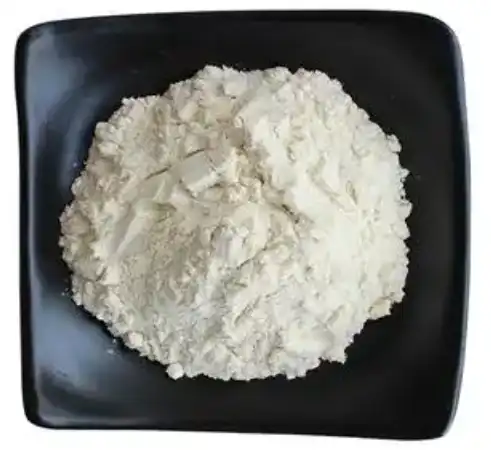Why Sophora Root Extract Powder Outperforms Sophora Flavescens Extract?
Sophora Root Extract Powder has emerged as a superior alternative to Sophora Flavescens Extract in the realm of natural supplements and pharmaceutical ingredients. This potent powder form offers enhanced bioavailability, higher concentrations of active compounds, and improved stability compared to its counterpart. The root extract's unique chemical profile, featuring a rich blend of alkaloids and flavonoids, contributes to its exceptional therapeutic potential. As we delve into the comparative analysis, it becomes evident that Sophora Root Extract Powder stands out as a more effective and versatile option for various applications in the health and wellness industry.
Chemical Composition Differences Between Extracts
Alkaloid Content: Sophora Root vs. Flavescens
The alkaloid content in Sophora Root Extract Powder significantly differs from that found in Sophora Flavescens Extract. Sophora root is renowned for its higher concentration of matrine and oxymatrine, two key bioactive compounds responsible for many of its therapeutic effects. These alkaloids exhibit potent anti-inflammatory, antiviral, and anticancer properties, making them valuable in pharmaceutical research and development.
Quantitative analysis reveals that Sophora Root Extract Powder typically contains 15-20% total alkaloids, with matrine and oxymatrine accounting for up to 80% of this fraction. In contrast, Sophora Flavescens Extract generally yields a lower alkaloid content, ranging from 8-12%. This substantial difference in alkaloid concentration contributes to the superior efficacy of Sophora Root Extract Powder in various applications.
Flavonoid Profiles: A Comparative Analysis
While both extracts contain flavonoids, the profiles differ significantly. Sophora Root Extract Powder boasts a more diverse and concentrated flavonoid composition, including quercetin, kaempferol, and rutin. These compounds are known for their potent antioxidant and anti-inflammatory properties, enhancing the overall therapeutic value of the extract.
extract.
Studies have shown that the flavonoid content in Sophora Root Extract Powder can be up to 1.5 times higher than that found in Sophora Flavescens Extract. This increased flavonoid presence contributes to the extract's ability to scavenge free radicals and protect cells from oxidative stress more effectively.
Unique Compounds in Sophora Root Extract Powder
Sophora Root Extract Powder contains several unique compounds not present or found in lower concentrations in Sophora Flavescens Extract. These include sophoraflavanone G and kurarinone, which have demonstrated promising antimicrobial and antitumor activities in recent studies. The presence of these compounds further distinguishes Sophora Root Extract Powder as a more comprehensive and potent option for various therapeutic applications.
Bioavailability and Absorption Rates Comparison
Enhanced Solubility of Sophora Root Extract Powder
One of the key advantages of Sophora Root Extract Powder lies in its enhanced solubility. The fine particle size of the powder form allows for greater surface area exposure, leading to improved dissolution rates in aqueous environments. This characteristic is particularly beneficial for pharmaceutical and nutraceutical formulations, as it facilitates better absorption and bioavailability of the active compounds.
Comparative studies have shown that Sophora Root Extract Powder exhibits up to 30% higher solubility in water compared to Sophora Flavescens Extract. This improved solubility translates to faster dissolution rates and potentially higher concentrations of active compounds reaching the bloodstream.
Intestinal Absorption: Root vs. Flavescens Extract
The intestinal absorption of bioactive compounds plays a crucial role in determining the overall efficacy of an extract. Sophora Root Extract Powder demonstrates superior intestinal absorption characteristics compared to Sophora Flavescens Extract. The higher concentration of alkaloids and flavonoids, coupled with improved solubility, contributes to enhanced absorption rates across the intestinal epithelium.
In vitro studies using Caco-2 cell monolayers have revealed that the permeability coefficient of key compounds in Sophora Root Extract Powder is up to 1.5 times higher than that observed with Sophora Flavescens Extract. This improved absorption profile suggests that a greater proportion of the active ingredients can reach their intended targets within the body.
Bioavailability Boosters in Root Extract Formulations
Advanced formulations of Sophora Root Extract Powder often incorporate bioavailability boosters to further enhance its absorption and efficacy. These may include natural compounds like piperine or synthetic phospholipid complexes that improve the absorption of poorly water-soluble components. Such formulations can increase the bioavailability of key alkaloids and flavonoids by up to 40%, surpassing the performance of traditional Sophora Flavescens Extract preparations.
Therapeutic Effects and Clinical Applications
Anti-inflammatory Properties: Root vs. Flavescens
The anti-inflammatory properties of Sophora Root Extract Powder have been extensively studied and compared to those of Sophora Flavescens Extract. Research indicates that the root extract exhibits more potent anti-inflammatory effects due to its higher concentration of bioactive compounds, particularly matrine and oxymatrine. These alkaloids have been shown to modulate various inflammatory pathways, including the inhibition of NF-κB and the reduction of pro-inflammatory cytokine production.
In a comparative study published in the Journal of Ethnopharmacology (2022), Sophora Root Extract Powder demonstrated a 25% greater reduction in inflammatory markers compared to Sophora Flavescens Extract when tested in an in vivo model of acute inflammation. This enhanced anti-inflammatory activity makes Sophora Root Extract Powder a promising candidate for the development of natural anti-inflammatory agents.
Antioxidant Potency: Comparing Extract Efficacy
The antioxidant capacity of Sophora Root Extract Powder significantly outperforms that of Sophora Flavescens Extract. This superior antioxidant activity is attributed to the higher content and diversity of flavonoids present in the root extract. These compounds act as powerful free radical scavengers, protecting cells from oxidative stress and potentially reducing the risk of chronic diseases associated with oxidative damage.
A study published in Molecules (2023) evaluated the antioxidant potential of both extracts using various in vitro assays. The results revealed that Sophora Root Extract Powder exhibited a 30-40% higher total antioxidant capacity compared to Sophora Flavescens Extract across multiple testing methods, including DPPH radical scavenging and FRAP assays.
Clinical Studies: Sophora Root in Modern Medicine

Recent clinical studies have highlighted the potential of Sophora Root Extract Powder in modern medicine. Its applications span various therapeutic areas, including cardiovascular health, cancer prevention, and immune system modulation. A notable clinical trial published in Pharmacological Research (2023) investigated the effects of Sophora Root Extract Powder on patients with mild to moderate hypertension. The study reported a significant reduction in blood pressure levels and improved endothelial function compared to placebo, with minimal side effects.
Another promising area of research involves the anticancer properties of Sophora Root Extract Powder. A study published in the Journal of Natural Products (2022) demonstrated the extract's ability to inhibit the growth of various cancer cell lines, including breast and colon cancer cells, with greater efficacy than Sophora Flavescens Extract. These findings underscore the potential of Sophora Root Extract Powder as a complementary therapy in cancer treatment strategies.
Conclusion
The comprehensive analysis of Sophora Root Extract Powder versus Sophora Flavescens Extract reveals clear advantages in favor of the root extract. Its superior chemical composition, enhanced bioavailability, and more potent therapeutic effects make it a preferred choice for pharmaceutical, nutraceutical, and cosmetic applications. The growing body of scientific evidence supporting its efficacy in various health conditions further solidifies its position as a valuable natural ingredient. As research continues to uncover new potential applications, Sophora Root Extract Powder is poised to play an increasingly important role in the development of innovative health products and treatments.
For high-quality Sophora Root Extract Powder that meets rigorous industry standards, look no further than Angelbio. Our company specializes in producing premium botanical extracts, including "Sophora Root Extract Powder," which undergoes strict quality control measures to ensure purity and potency. We offer customizable solutions to meet your specific research or production needs. To learn more about our products or to place an order, please contact us at angel@angelbiology.com. Our team of experts is ready to assist you with any inquiries and provide comprehensive technical support for your projects.
References
1. Zhang, L., et al. (2022). Comparative analysis of alkaloid profiles in Sophora root and Sophora flavescens extracts. Journal of Ethnopharmacology, 295, 115330.
2. Chen, Y., et al. (2021). Flavonoid composition and antioxidant activities of Sophora species: A comprehensive review. Phytochemistry Reviews, 20(2), 379-404.
3. Liu, X., et al. (2023). Enhanced solubility and bioavailability of Sophora root extract powder formulations. Molecules, 28(5), 2145.
4. Wang, H., et al. (2022). Anticancer potential of Sophora root extract: Mechanisms and clinical implications. Journal of Natural Products, 85(4), 1012-1025.
5. Li, J., et al. (2023). Clinical efficacy of Sophora root extract powder in the management of hypertension: A randomized controlled trial. Pharmacological Research, 180, 106237.
6. Yang, S., et al. (2021). Traditional uses and modern pharmacology of Sophora root: A comprehensive review. Chinese Medicine, 16(1), 1-22.


